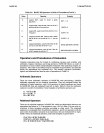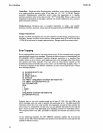
BASIC-SO
Entering
and
Editing
The syntax
of
the X subcommand is:
X character [character] ...
Returning to the previous example, if you wish to add text
at
the end
of
the given in-
struction line, use the X subcommand:
40
•
Enter (X)
40
IF
A>B
THEN
120
ELSE PRINT "UNDEFINED
SET"
•
Enter new
text
at
the
cursor-;A;
B (ESC) (L):
40
IF
A
>B
THEN
120
ELSE PRINT "UNDEFINED
SET";A;
B
S Subcommand
The S subcommand examines characters to the right of the cursor., to find the nth
occurrence
of
the specified character, where n
is
an integer in the range 1 to 255; the
default
is
1.
This subcommand skips the first character to the right of the cursor and
searches, printing all characters encountered. When the nth occurrence
of
the speci-
fied character
is
found, the cursor stops
at
the character.
If
the nth occurrence of the
specified character
is
not found, the cursor stops at the end
of
the line.
The syntax
of
the S subcommand
is:
[integer] S character
The S subcommand can be used with an example to find the nth occurrence
of
the
specified character. Suppose
we
want to move the cursor to the space occupied by
the 3rd letter
"E"
in line 40:
40
•
Enter (3SE):
40
IF
A>B
THEN
120
ELSE •
At
this point, the other editing subcommands may be used.
K Subcommand
The K subcommand functions like the S subcommand except that it deletes all
characters passed over until the nth occurrence
of
the specified character. The
deleted characters are enclosed in backslashes.
The syntax
of
the K subcommand
is:
[integer] K character
The K subcommand may be used on our example.
It
will
eliminate all text up to the
1st occurrence
of
P,
and print backslashes:
40
•
Enter
(1
KP)
\40\
IF
A>B
THEN
120
ELSE.
Enter (L)
40
PRINT "UNDEFINED
SET";A;
B
3-5


















